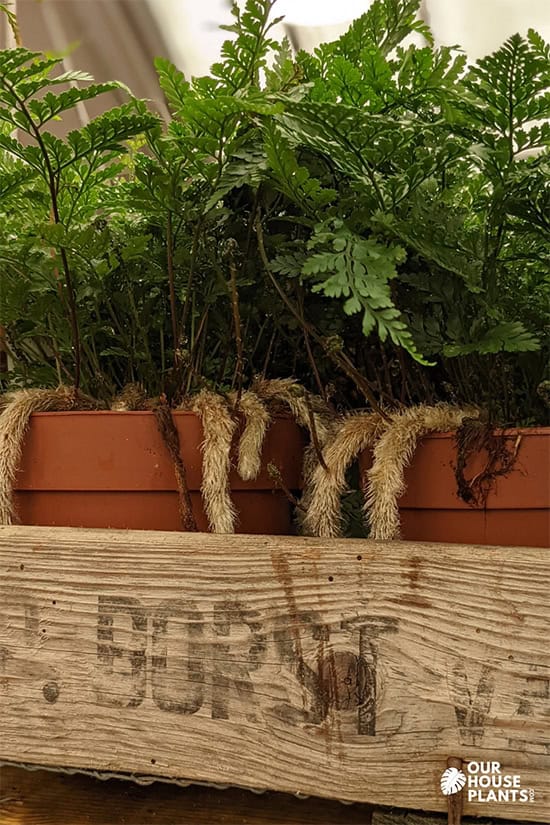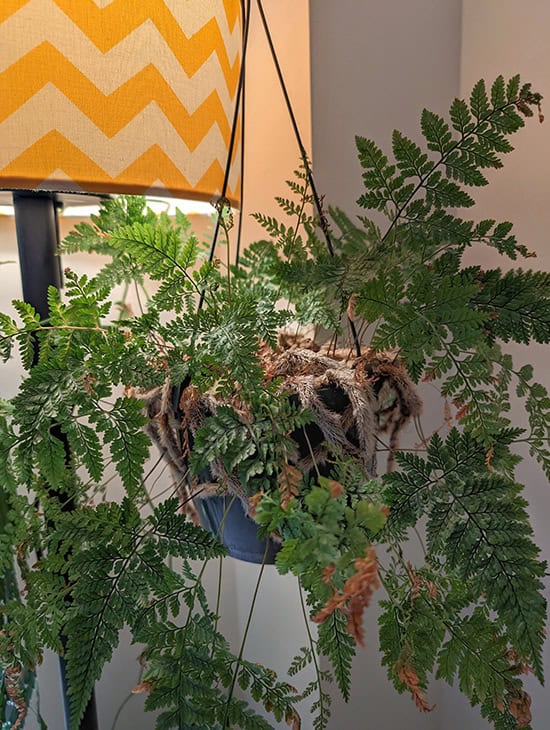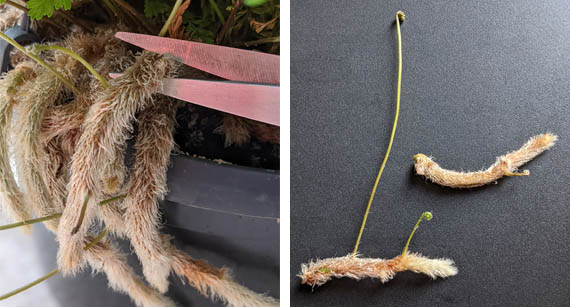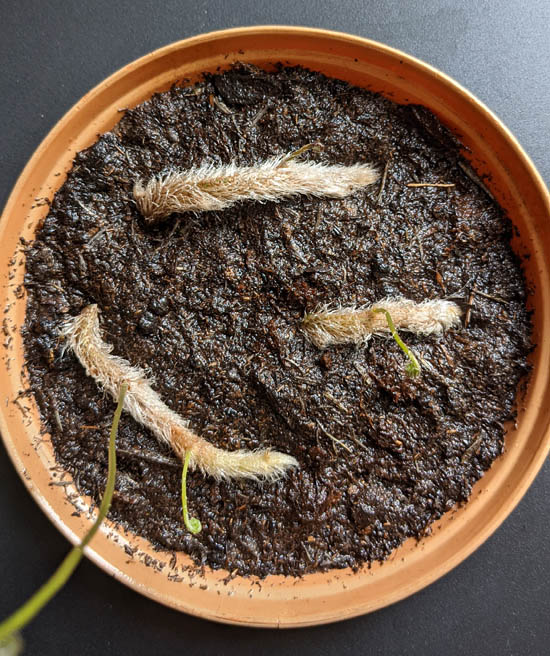Davallia tyermannii and Humata tyermanii, also known as the Rabbit's Foot Fern, have two major selling points.
Firstly, those furry rhizomes they look freaking amazing / unusual / cute (delete as appropriate!) and secondly, they're perhaps the easiest and most forgiving Fern you can grow as a houseplant.
Not overly fussy about light levels and their dislike of a strict fixed watering routine make them an excellent pick for those who love the delicate and tranquil look of a fern without the typical hassle that's often attached to these types of houseplants.
The furry rhizomes of Davallias are covered in hairy scales and look like Rabbits Feet. (Or, to some, maybe Tarantula legs!)
It's a fabulous, easy-going fern for sure, although not massively popular for some reason. I do feel in time it will climb higher in the "desirable" stakes.
This is because all the traditional ferns can be difficult as they have fussy or messy natures with "leaf drop", whereas the Rabbit's Foot is as good as gold and at the same time, looks tidy and handsome.
How do you pronounce Davallia correctly? Say:
dav-VAL-ee-uh
Of course, the hairy legs or rhizomes are a huge talking point for these plants, but the lacy foliage is both superbly tactile and delicate looking. If you look carefully, you'll see new fiddleheads emerging along the length of the rhizomes.
This is different from many other ferns, where they would typically sprout out out from a central crown or caudex.
The fronds might look thin and delicate but I've found that they don't mind being handled and will cope with some brush past in high traffic areas.
Many other ferns just wouldn't put up with this, Boston Fern and Maidenhair Hair, I'm looking at you here. Failing to grow one of these divas successfully can put a person off all ferns for life. But if you love the textured foliage and the tranquil feelings they can create, then I really recommend giving Davallias a try.
The delicate-looking, dark green triangular fronds are finely divided and can grow to 15cm / 6in long.
A wide range of Davallias appear very similar, with very subtle differences between species at most. Most Rabbit Foot Ferns being sold are going to be Davallia canariensis, Davallia fejeensis, Davallia tyermannii or Humata tyermanii / humata tyermannii.
Fortunately, being so closely related means the differences don't affect how they need to be cared for so the scientific name classification is less important here.
Did you know?
This fern hails from the Fiji islands and goes by many common names including Silver Hare’s Foot Fern, Bears Paw Fern and Squirrel Fern. All the names are a result of the distinctive rhizomes.
Larger, older plants with lots of aerial roots and foliage, like almost any houseplant, will cost more than young smaller ones. If you have a tight budget but patience, then small is the way to go. After a few years with proper care, it will be significantly bigger.
If you have money to invest in something more prominent from the start or have no patience for growing it on, going big from the start could be the way to go. I found the most expensive and impressive-looking ones were those giant beasts all bundled up into a hanging basket.
Rabbit Foot Ferns used to be very hard to get hold of, but fortunately they're a much more common sight in houseplant stores today.
All species are commonly sold, but I feel like it hasn't quite reached peak popularity, so it might not be sold everywhere. In the meantime, when all else fails, you can get some really healthy looking plants and some grown in very unusual ways over on Etsy*. I've also seen a small number of sellers selling some on eBay*, so check out both for the best deals.
*Our website is free because it's supported by our users. We'll sometimes earn a small commission when you buy something through the affiliate links on our site.
That's the basics out of the way so let's move on and look at how to take care of and grow a Davallia Fern.

Hi, I'm Tom!
If you're like me and enjoy the challenge of growing houseplants and getting them to thrive, then Ourhouseplants can help. This website shares my knowledge and years of growing plants and provides (hopefully) helpful advice on properly caring for your indoor plant friends.
These plants will take a broad range of light levels and be reasonably happy with what you can provide. A bright spot with some dappled sunlight is the perfect spot. If you can give it that, your Rabbits Foot will love you.
If you can't quite meet those growing conditions, the good news is that they'll also grow in an area with lower light. You can also place them in much brighter spots with direct sunlight like in an east-facing window.
Both areas are classed as more "extreme" though, so do watch your plant for problems and if they develop it's telling you it can't adapt and needs to be moved to somewhere more favorable.
The signs you need to look for are:
At least some light is needed, if you don't have a great deal, you can postion them near an LED light (they do work for growing plants!)
Many ferns grow directly in the ground with soil that tends to stay cool and moist for much of the time. So as houseplants they prefer their roots to be growing in a moist growing medium. Makes sense, right?
About those fuzzy rhizomes
They support, trap, absorb and even store water for your plant in times of drought. New fronds will also grow from them. They're crucial, so don't remove any unless you have to.
Well, with epiphytic plants like Davallias, when growing natively, their actual roots are quite shallow. Instead the furry aerial rhizomes grip and hang around other plants or trees and only receive water and nutrients when it occasionally rains.
The rhizomes are thick and the fury material helps trap and absorb the little water that falls. They also act as storage vessels and will support your plant during droughts.
All of this together means they're used to drier areas and harsher growing conditions than your traditional ferns, so as houseplants they'll be much more forgiving.
TL;DR - These plants don't mind drying out a little bit from time to time. Although they grow best in moist soil, they don't need to be kept constantly moist.
For plants in bright locations growing in warm temperatures, expect to water once or twice a week during the growing seasons. In lower light conditions or during Winter, once every week or two is likely to be enough.
Under watered plants will look a little washed out and the fronds will have a subtle wilt. The soil will also be very dry.
Over watered plants can also look a little washed out, but it will have limp fronds and the soil will be wet to the touch.
You wait for ages to find one of these in store and then two come along at once.
Native to tropical regions of the Pacific, Australia, Asia, and Africa this plant prefers higher humidity levels. But it's not an essential requirement.
In fact, of all ferns, this one is potentially the best at dealing with low humidity without any adverse effects. For example it's rare to experience leaf drop or large numbers of brown tips.
Extreme and unnatural areas around your homes could be too much though. So move away from ovens, fires and air conditioning vents. You can skip the daily misting too, and here's why.
While not a heavy feeder, it will still benefit from a well balanced feed every few months whenever it's in active growth and producing new green fronds. Liquid fertilizer gives you full control, but you can also sprinkle over a few slow release pellets once a year (they normally last up to 6 months).
Like many of the other care requirements, they aren't particularly fussy. They're not a fan of the cold or excessively hot weather though. Look to provide a temperature range between 10°C (50°F) - 24°C (75°F).
The majority of growth occurs above soil level. So this will be the foliage and those hairy "legs", the root system that grows in the soil is fairly basic and not as strong as many other plants. This means they will do quite well in shallow pots.
They're like many ferns in that over time the roots will form a dense compacted mass. Almost like really fine netting or thread.
Over many years they will "eat" all the potting soil and all you'll have left is the roots. At this point, it could be a good idea to consider repotting to refresh the potting medium and provide more space for the roots to grow.
Be careful not to plant those rhizomes!
They must never be "buried" in soil. They're designed to "live" in the air and grow over the soil surface only and should never be covered. Doing this will cause them to rot.
On average, you're unlikely to need to repot mature plants more than once every two or three years. I've not done anything with mine since I brought it and it's still magnificent and growing well. Plants that are very young or those growing very fast will need to be repotted more frequently.
Although the roots don't need much space, those rhizomes sure do! It's likely their growth will cause you to think about repotting way before the actual roots do. They can completely grow over and around pots and containers in a fairly short time, almost swallowing them. When this happens you can go ahead and move them into something bigger.
They'll accept a broad range of growing mediums. Some people have them growing in regular houseplant compost and others will mount them or grow them in sphagnum moss. Both of these are fine.
If you opt for something else, that could work too. Just know that the growing medium shouldn't hold excessive amounts of water nor should it be excessively porous. These ferns do like water and it must be able to stick around the roots to be able to absorb it.
Propagating spores
It's both hard and time consuming for the average houseplant owner to propagate new plants from the spores that are occasionally produced. But if this is something you want to try, here's a video showing you how to do it.
This houseplant makes a delightful and easy gift for many occasions, you might also want a couple dotted around your home. So propagation is something you might want to try.
If you have a larger plant, it's easy to propagate more.
The simplest and potentially the most effective way to do it is by dividing the plant into two (or more pieces if it's very large). This just involves just splitting the plant in half and then potting up each half into it's own container.
But what if you don't want to lose the size and bulk of your "mother" plant?
If you don't mind losing the odd fuzzy rhizome, this could be the better way to propagate your Rabbits Foot Fern. It simply involves cutting them off with a sharp knife or scissors to create cuttings that are around 5cm / 2” inches.
Pick rhizomes that have at least one recently sprouted frond attached to the cutting. You can see both steps in the photo below.
Left - Cutting healthy roots for propagation. Right - How the cuttings should look.
The next step is to fill a container with compost (or another suitable growing medium). You then just need to place the cuttings on top with the emerging frond facing upwards. No burying is necessary as this can cause the cutting to rot before they establish.
Make sure there is plenty of contact with the growing medium. If you find your cuttings are not staying put, pin the rhizomes in place with the help of wire or toothpicks.
Cuttings may stay put by themselves. If they don't you can pin them into place.
Keep the medium moist and after a few weeks fronds should unfurl and before long, new roots will establish and you will start to see new growth. At this point you can consider separating them into individual pots or put them all into one. This will give you a bulky and full-looking plant much quicker.
In my experience, I haven't found this to be a fast-growing plant. That said, each new frond takes up a fair amount of space once it's fully unfurled. This can rapidly make the plant look more prominent and give the impression of more impressive growth than what's actually happening.
That said, over many decades (yes, they'll easily live that long with decent care - This lady had her's in an office for more than 30 years.) they can become pretty large.
They won't get overly tall, but they'll certainly grow over and around whatever container or pot you put them in.
The fronds can be parted and moved a little to suit the appearance you want, so you're in control of how it looks and space it will take up. For example, if you want it placed against a wall, you can part all the fronds that will be crushed between the pot and the wall.
This is a plant strictly grown for its quirky "feet" and handsome fronds. No flowers here.
This fern is not harmful to people and pets. Source - ASPCA
Small plants are easy to grow in your typical pot. But as they age, they'll "climb" out and quickly outgrow this look.
These plants are unusual and quirky by their nature, so why not just go with it and grow them in equally impressive and wacky pots or containers. Darryl Cheng over at Houseplant Journal grew his in a glass coffee pot before transferring it to a Goalie Mask. A fab Halloween centerpiece!
If you want to see how it looks and learn how he did it, check out the video below.
Davallia fejeensis being planted into a Mask. A fantastic Halloween idea for houseplant lovers
Brown Scale Insects.
In my experience, the majority of the frond stems have small brown discs that resemble brown Scale Insects. Here is a photo showing this.
Brown Scale Insects or something less sinister?
Summer Rayne Oakes also observes that she has experienced Brown Scale Insects on every Rabbit Foot Fern she's owned, but she noticed it never spread to her other houseplants or caused any major issues.
So when I noticed it on my plants I didn't overthink it. However, after a couple of years I'm dubious this is actual Scale at all. Simply because Scale will travel to other plants, they will make a sticky mess with their secretions and above all, they stick to plants and won't rub off easily.
None of this was happening with mine, in particular the "scale" would just come away if I gently wiped my finger over the stem. That's not classic Scale Insect behavior. So what could be happening?
Generally, new "fiddleheads" emerge from the fuzzy aerial roots. When this happens and the frond pushes through and grows longer, it brings with it some of the brown fuzz from the roots which gently sticks to the frond. As mentioned you can just brush the fuzz away if you want.
Something similar also happens with the Bird Nest Fern.
While I do think these plants can be affiliated with Scale pests at times, I think you have to run through the checklist above to help determine if you do actually have this problem. Assuming you do, then you can treat in the usual way. If you're not sure how, we've written about this separately over on our pest article.
Very dark brown or black rhizomes.
This is a tell tale sign of your plant being heavily overwatered. Try to keep the soil moist during the growing seasons. It will be fine if you let it dry out a little but always avoid the soil being wet.
What we mean by this is that water should not drip out if the planter is turned upside down or you squeeze the soil with a finger. If you do either of these things and water is coming out, then there is too much moisture in the soil medium.
Brown or black rhizomes could also be caused if they're buried in the potting medium. Make sure they only sit on top of the surface and not underneath it.
Pale Fronds.
All three of the following can cause a sickly pale green look:
Bronze Fronds.
On many plants, new leaflets will emerge and quickly take on a brown or bronze hue. Over a few weeks they'll change to a light, sometimes yellowish green. Finally, after many months, the fronds will take on their "mature" and much more familiar color, which is typically a darker green.
This photo shows a mixture of mature, juvenile and in between fronds
You can see all stages of this in the photo above. The Bronze coloring is towards the top. The light green towards the bottom and the mature colors underneath.
All of this is entirely normal and just part of the plant's growing cycle. It's important not to confuse the bronze with completely gone over leaves that go brown. I explore this in the problem below.
Brown Leaves / Fronds.
Although these are evergreen ferns, no frond will live forever and there will come a time it will brown up and be replaced by a new one.
Extreme drought or prolonged underwatering will also cause sporadic browning over random parts of the plant. These plants also seem a lot more prone to brown tips if the above is combined with low humidity levels.
Epiphytic ferns seem pretty popular in recent years. As a result, many Davallia varieties and the Staghorn Fern have become a familiar sight in many well stocked garden centres and big box stores.
The first time I clapped eyes on a Rabbit's Fern was at Halloween in a store. The workers had decorated around the area accordingly and in my mind (trigger warning) the roots suddenly changed from cute rabbit feet to tarantulas legs!!
"Not a chance! No no no! Who'd want one of those in their home!?" I gasped before hurrying away.
Something you need to know about me for this next bit to make sense. I'm the type of person that sometimes needs a little time and space to think more objectively. I'm also a sucker for any houseplants in distress (I've been known to slyly water parched plants in restaurants, bars, and friends' houses when no one is looking).
The aerial roots of Davallias look like Rabbits Feet
Fast forward to the following summer when visiting the same garden nursery. It was a hot sunny day and there were two poor Rabbits Ferns hanging on a display bar in a window facing the extreme summer heat.
One was completely toasted. The other hanging on but desperate. I snatched it off the hanging bar and brought it there and then, before dashing home to drench it under the shower for 5 minutes straight. Pretty sure I saved its life that day. ;-) Score one for the houseplant rescuers!
...Think Cute Rabbits Feet not Hairy Tarantulas Legs (unless you're into those of course!).
Since that Mission Impossible moment, it's grown like crazy in a tricky spot that I struggled to fill before (low light at the bottom of a staircase with occasional brushing passed as people go up and down).
I'd like to think it was thankful for the rescue and expressing this, with all the lush foliage eye candy, but in truth it's just in its nature to do well in our home environments.
I'm OK, but not great, with growing Boston ferns, but the Davallia is truly a walk in the park. Recommend them completely. You just have to have the right association when you see the legs. Think Cute Rabbits Feet not Creepy Tarantulas Legs (unless you're into those of course!).
(Gallery) Photo credit of plants for sale at Walmart - Forest Starr and Kim Starr









